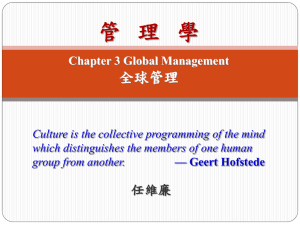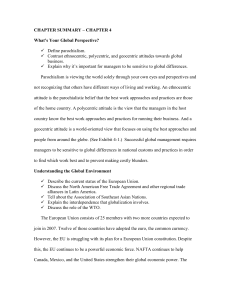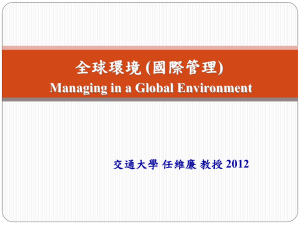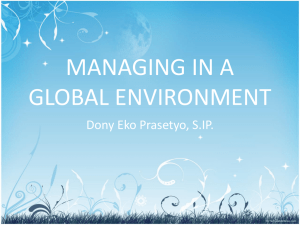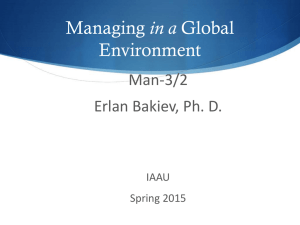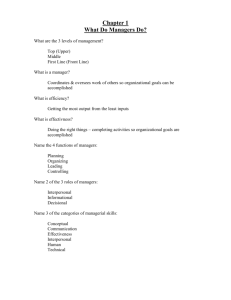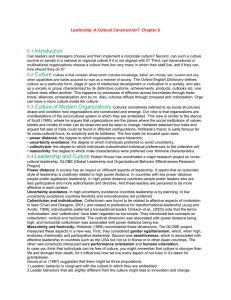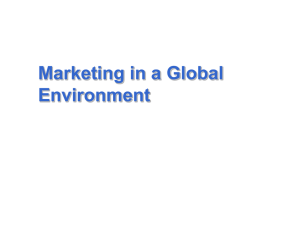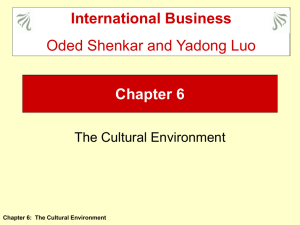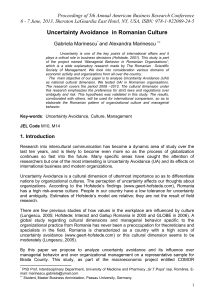Ch.3 Managing in a Global Environment
advertisement
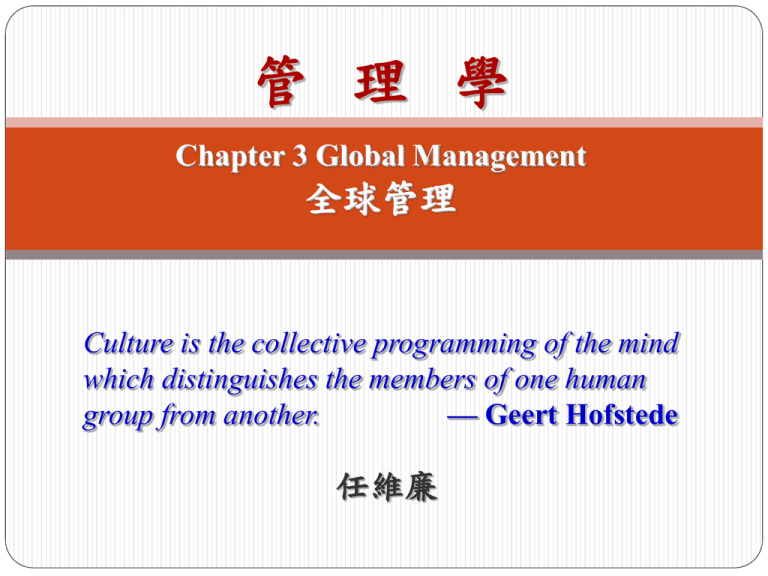
管 理 學 Chapter 3 Global Management 全球管理 Culture is the collective programming of the mind which distinguishes the members of one human group from another. — Geert Hofstede 任維廉 1. 妳今天早上怎麼起床的? 2. national culture vs. organization culture, 何者影 響員工行為更大? 3. 企業界最有用的語言是英文,第二呢? 4. Global thinking, local action. 開車一定是向右行 駛?西方人如何分辨來自東方的觀光客?龍的 傳人?洗門風 ? 5. “culture shock” 6. Who owns what? 2 Culture shock the difficulty people have adjusting to a new culture that differs markedly from their own. (Wiki) 3 實做練習Case: Who Owns What? Acer, Apple, Ben and Jerry’s Ice Cream, Coke, Disney, GE, Godiva, Green Giant, Grey Hound, Heineken, Holiday Inn, Hyundai, ThinkPad, Ikea, Intel, LG, Lipton Tea, Marlboro, McDonald, Microsoft, Nestle, Nokia, P&G, Philips, Rolex, Sam Sung, Shell, Sony, Swatch, Toyota, Tropicana, Volvo, Wal-Mart, Wrangler Jens, 世界級品牌 http://www.interbrand.com/zh-CHT/best-global-brands/best-global-brands-2008/best-global-brands-2011.aspx 今年 排名 去年 排名 品牌 今年 排名 去年 排名 品牌 1 1 Coke 8 17 Apple 2 2 IBM 9 9 Disney 3 3 Microsoft 10 10 Hp 4 4 Google 11 11 Toyota 5 5 GE 14 8 Nokia 6 6 McDonald 17 19 Sam sung 7 7 Intel 98 -- HTC 5 2011年二十大台灣國際品牌 排名 品牌 公司名稱 品牌價值 (億新台幣) 1 宏達國際 1047.56 2 宏碁公司 563.74 3 華碩電腦 475.71 4 趨勢科技 353.49 5 康師傅控股 345.85 6 2011年二十大台灣國際品牌 排名 品牌 公司名稱 品牌價值 (億新台幣) 6 旺旺食品 214.78 7 巨大機械 97.91 8 正新輪胎 97.41 9 聯強國際 92.08 10 研華公司 69.99 7 2011年二十大台灣國際品牌 排名 品牌 公司名稱 品牌價值 (億新台幣) 11 12 13 14 15 16 17 18 19 20 85℃ D-Link Merida Transcend CyberLink Zyxel Delta Uni-president Johnson KGI 美食達人 友訊科技 美利達工業 創見資訊 訊連科技 合勤科技 台達電子 統一企業 喬山健康 凱基證券 63.53 58.30 54.29 42.30 40.70 40.56 40.53 39.75 39.71 28.83 8 BenQ-Siemens Case 的教訓 1. 財務評鑑 2. 品牌 /品質 3. 執行力: 管理能力 人才素質 http://hotline.ccsinsight.com/_images-article/benq-siemens-logo.jpg 9 綱 要 1. What’s your global perspective? 全球視野 vs. 偏狹地域觀念 2. Understanding the global environment: 變遷的全球環境 3. Doing business globally: 國際化之三階段 4. Managing in a global environment, 外國環境之管理 10 1. 全球視野 Parochialism viewing the world solely through your own perspectives, leading to an inability to recognize differences between people. 討論: 聯合國考題:你對於世界糧食短缺問題的看法。從美 國 (台北) 看天下。世界是平的,只要有網路和雄心。 全世界的夜景,Facebook map,宗教禁忌,日本習俗, 不雅的手勢。 11 12 Paul is an intern on Facebook’s data infrastructure engineering team. http://www.facebook.com/note.php?note_id=469716398919.ksh/sg 討論:Usama bin Laden, Jr., Leonardo da Vinci, Barack Hussein Obama II 14 15 16 17 18 Adopting a Global Perspective Ethnocentric Attitude, 種族優越中心 The parochialistic belief that the best work approaches and practices are those of the home country. Polycentric Attitude,多中心 The view that the managers in the host country know the best work approaches and practices for running their business. Geocentric Attitude, 地球為中心 A world-oriented view that focuses on using the best approaches and people from around the globe. 19 2. 變遷的全球環境: 區域貿易聯盟 Regional Trading Alliances 1. 歐盟, European Union (EU) - a union of 27 European nations created as a unified economic and trade entity Euro - a single common European currency 2. 北美自由貿易協定, North American Free Trade Agreement (NAFTA) - an agreement among the Mexican, Canadian, and U.S. governments in which certain barriers to trade have been eliminated. 3.東協, Association of Southeast Asian Nations (ASEAN), Trading alliance of 10 Southeast Asian nations, 加1,3,6 討論:蘇東坡? BRICs, PIGS, African Union, Southern Cone Common Market (Mercosur), 20 Exhibit 3-1: European Union Map Mercousur Members 22 ASEAN Members 23 Global Trade Mechanisms The World Trade Organization (WTO) - a global organization of 153 countries that deals with the rules of trade among nations. (30 observer governments) Evolved from the General Agreement on Tariffs and Trade (GATT) in 1995. International Monetary Fund (IMF) - an organization of 185 countries that promotes international monetary cooperation and provides advice, loans, and technical assistance. 24 Global Trade Mechanisms World Bank Group - a group of five closely associated institutions that provides financial and technical assistance to developing countries. Organization for Economic Cooperation and Development (OECD) - an international economic organization that helps its 30 member countries achieve sustainable economic growth and employment. 25 G7, G8 (Group of Eight), G-20 八大工業國組織 英國, 法國, 德國, 美國, 日本, 義大利, 加拿大, 俄羅斯 G-20 擁有全球65%的人口,85%經濟活動 阿根廷,澳大利亞,巴西,中國,歐盟,印度,印尼, 韓國,墨西哥,沙烏地阿拉伯,南非,土耳其 26 Taiwan 的困境: FTA ECFA - Economic Cooperation Framework Agreement, APEC - 亞太經合會 韓國與歐盟及美國簽署 FTA TIFA - 台美貿易暨投資保障協定 TPP - 泛太平洋戰略經濟 夥伴關係協定 (Trans-Pacific Strategic Economic Partnership Agreement) 新加坡、馬來西亞、汶萊、越南、日本 加拿大、美國、墨西哥,秘魯、智利 澳洲、紐西蘭 27 3. 國際化之三階段 How Organizations Go Global 1. 外包 2. 進出口,授權,特許加盟 3. 策略聯盟,合資,外國子公司 28 Multinational Corporation (MNC): Maintains operations in multiple countries. Multinational Corporation (MNC) - a broad term that refers to any and all types of international companies that maintain operations in multiple countries. 1. Multidomestic Corporation - an MNC that decentralizes management and other decisions to the local country. 2. Global Company - an MNC that centralizes management and other decisions in the home country. 3. Transnational or Borderless Organization - an MNC in which artificial geographical barriers are eliminated. (reflect a geocentric attitude) 29 台灣傳統產業之發展軌跡 從小開始, 為外國客戶代工(成為OEM), 跨國分工, 投入研發設計, 掌握核心客戶(成為ODM), 提升台灣為營運總部, 自建品牌通路。 討論:Smile curve, 台灣十大國際品牌? 30 世界級品牌 Apple Google Coke, Microsoft, IBM, GE, Intel, Disney, McDonald, Nokia, Toyota, Sam Sung, Source: http://images.businessweek.com/ss/09/09/0917_global_brands/index.htm?technology+slideshows Louis Vuitton, China Mobile, 台灣? 31 十大台灣國際品牌 1.趨勢科技 6.巨大機械 2.華碩電腦 7.明基電通 3.宏碁公司 8.合勤科技 4.康師傅 9.聯強國際 5.正新橡膠 10.威盛電子 32 4. 外國環境之管理 1. 政法、經濟環境 2. 文化環境 個人、集體主義 權力差距 不確定之規避 成就或教養(重量或質,陽剛、陰柔) 長、短期導向 補充資料:南斯拉夫鈔票,女人女人 33 34 35 36 37 Managing in A Global Environment The Legal Environment Stability or instability of legal and political systems Legal procedures are established and followed Fair and honest elections held on a regular basis Differences in the laws of various nations Effects on business activities Effects on delivery of products and services 38 The Economic Environment Free Market Economy - an economic system in which resources are primarily owned and controlled by the private sector. Planned Economy - an economic system in which economic decisions are planned by a central government. Monetary and Financial Factors Currency exchange rates, Inflation rates, Diverse tax policies 39 The Cultural Environment National Culture - the values and attitudes shared by individuals from a specific country that shape their behavior and beliefs about what is important. May have more influence on an organization than the organization culture. Global Leadership and Organizational Behavior Effectiveness (GLOBE) program - a research program that studies cross-cultural leadership behaviors. 40 Exhibit 4–6 What Are Americans Like Americans are very informal. Americans are direct. Americans are competitive. Americans are achievers. Americans are independent and individualistic. Americans are questioners. Americans dislike silence. Americans value punctuality. Americans value cleanliness. 41 Hofstede’s Framework for Assessing Cultures Individualism versus Collectivism Long-Term versus Short-Term Orientation Power Distance Culture Achievement versus Nurturing Uncertainty Avoidance 42 Exhibit 3–5 Hofstede’s Five Dimensions of National Culture (1) Individualistic — people look after their own and family interests Collectivistic — people expect group to look after and protect them Individualistic United States, Canada Australia Collectivistic Japan Mexico, Thailand (2) High power distance—Accepts wide differences in power, great deal of respect for those in authority Low power distance—Plays down inequalities: employees are not afraid to approach nor are in awe of the boss High power distance Mexico, Singapore, Low power distance Italy, Japan United States, Sweden Exhibit 3–5 Hofstede’s Five Dimensions of National Culture (3) High uncertainty avoidance—Threatened with ambiguity and experience high levels of anxiety Low uncertainty avoidance— Comfortable with risks; tolerant of different behavior and opinions High uncertainty avoidance Italy, Mexico, France Low uncertainty avoidance United Kingdom Canada, United States, Singapore (4) Achievement—Values such as assertiveness, acquiring money and goods, and competition prevail Nurturing—Values such as relationships and concern for others prevail Achievement United States, Japan, Mexico Canada, Greece Nurturing France, Sweden Exhibit 3–5 Hofstede’s Five Dimensions of National Culture (5) Long-term orientation—People look to the future and value thrift and persistence Short-term orientation — People value tradition and the past Short-term thinking Germany, Australia, United States, Canada Long-term thinking China, Taiwan, Japan Examples of Hofstede’s Cultural Dimensions Source: Based on G. Hofstede, “Motivation, Leadership, and Organization: Do American Theories Apply Abroad?” Organizational Dynamics, Summer 1980, pp. 42–63. 46 Hofstede’s Cultural Dimensions PDI (Power Distance Index) 低平權 IDV (Individualism) 低將團體的利益置於 個人之上 MAS (Masculinity) 高強調積極進取、成功 低強調生活品質、人際關係、社會服務 UAI (Uncertainty Avoidance Index) 高不能容忍沒有規章 LTO (Long-Term Orientation) 高強調節儉、忍耐,為了長遠的未來 http://www.geert-hofstede.com/ 47 Exhibit 3–6 GLOBE Highlights Source: M. Javidan and R. J. House, “Cultural Acumen for the Global Manager: Lessons from Project GLOBE,” Organizational Dynamics, Spring 2001, pp. 289–305. Copyright © 2001. Reprinted with permission from Elsevier. 48 Contemporary Issues Cultural Intelligence - cultural awareness and sensitivity skills. Global Mind-Set - attributes that allow a leader to be effective in cross-cultural environments. 49 Global mind-set Inventory (GMI) 知識資本:嫻熟全球企業營運,掌握複雜狀況, 開拓國際視野。 心理資本:熱愛多元文化,渴望冒險,自我肯 定。 社會資本:能和不同文化背景的人建立信任關 係,發揮人際影響力,善用外交手腕。 hbr.org/globalize-yourself-list Do your assignment: 1~5組 1. Case study: a manager’s dilemma (p.98) 2. Thinking critically about ethics (p.118) 3. Skill exercise: Collaboration skill (p.118) 4. Team exercise: Global aptitude assessment (p.118) 5. Internet-based exercise (p.118), cross cultural awareness http://www.kwintessential.co.uk/resources/culture-tests.html 5 1 回顧 比較:1. 全球視野 VS. 偏狹地域觀點 2. 國家 VS. 組織文化 3. 文化衝擊 (culture shock) 52 補充:改變全球經濟板塊的因素 1. 海洋世紀,工業革命 2. 資本主義 3. 資訊科技:網路,通訊 討論:遙測 (remote sensor) 技術,GPS, GIS,Digital Earth 53 54 Terms to Know parochialism born globals ethnocentric attitude global sourcing polycentric attitude exporting geocentric attitude importing European Union (EU) licensing Euro franchising North American Free Trade strategic alliances Agreement (NAFTA) Association of Southeast Asian Nations (ASEAN) World Trade Organization (WTO) multinational corporations (MNCs) multidomestic corporation global company transnational or borderless organization joint venture foreign subsidiary market economy command economy national culture GLOBE wikis blogs 55
